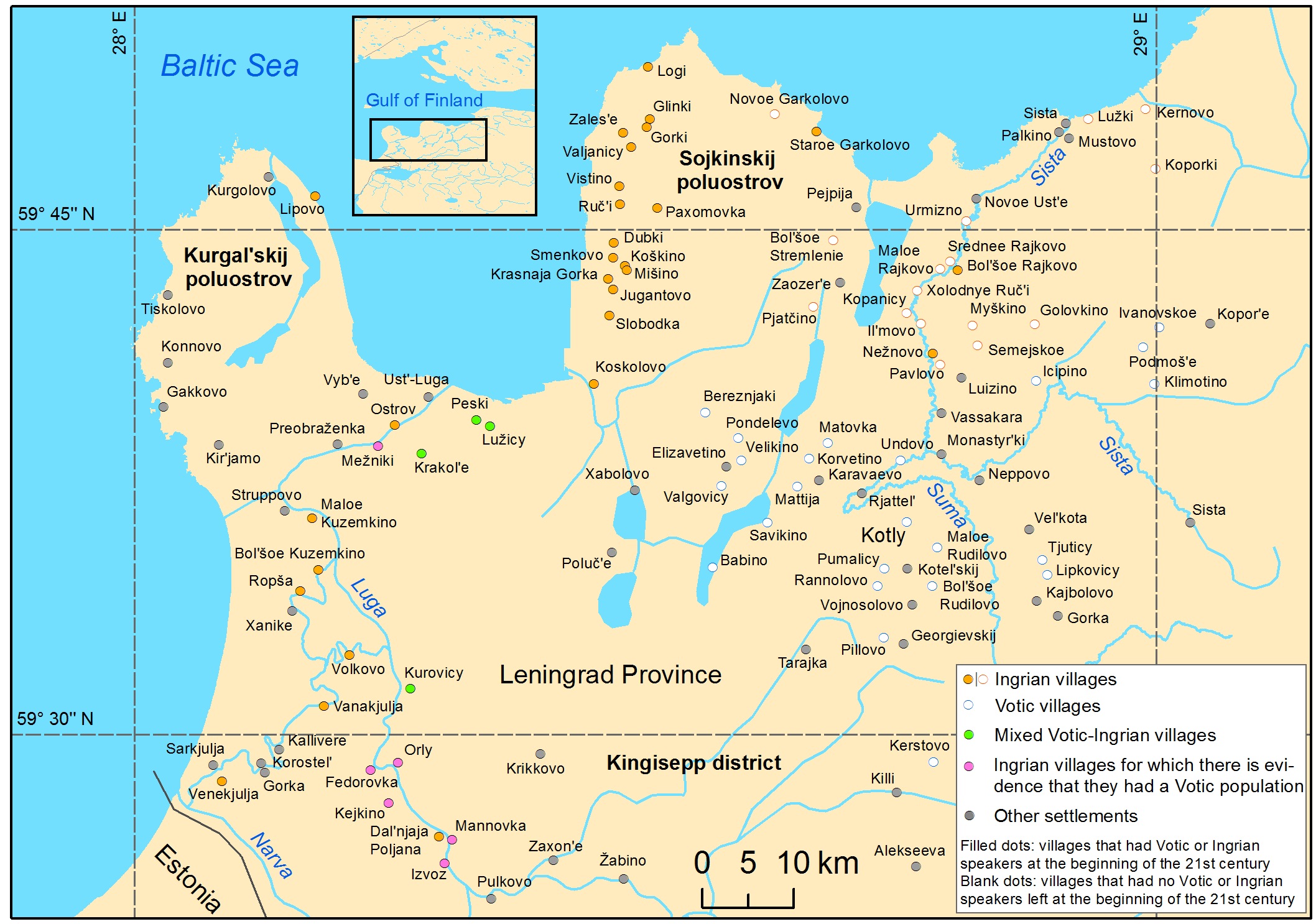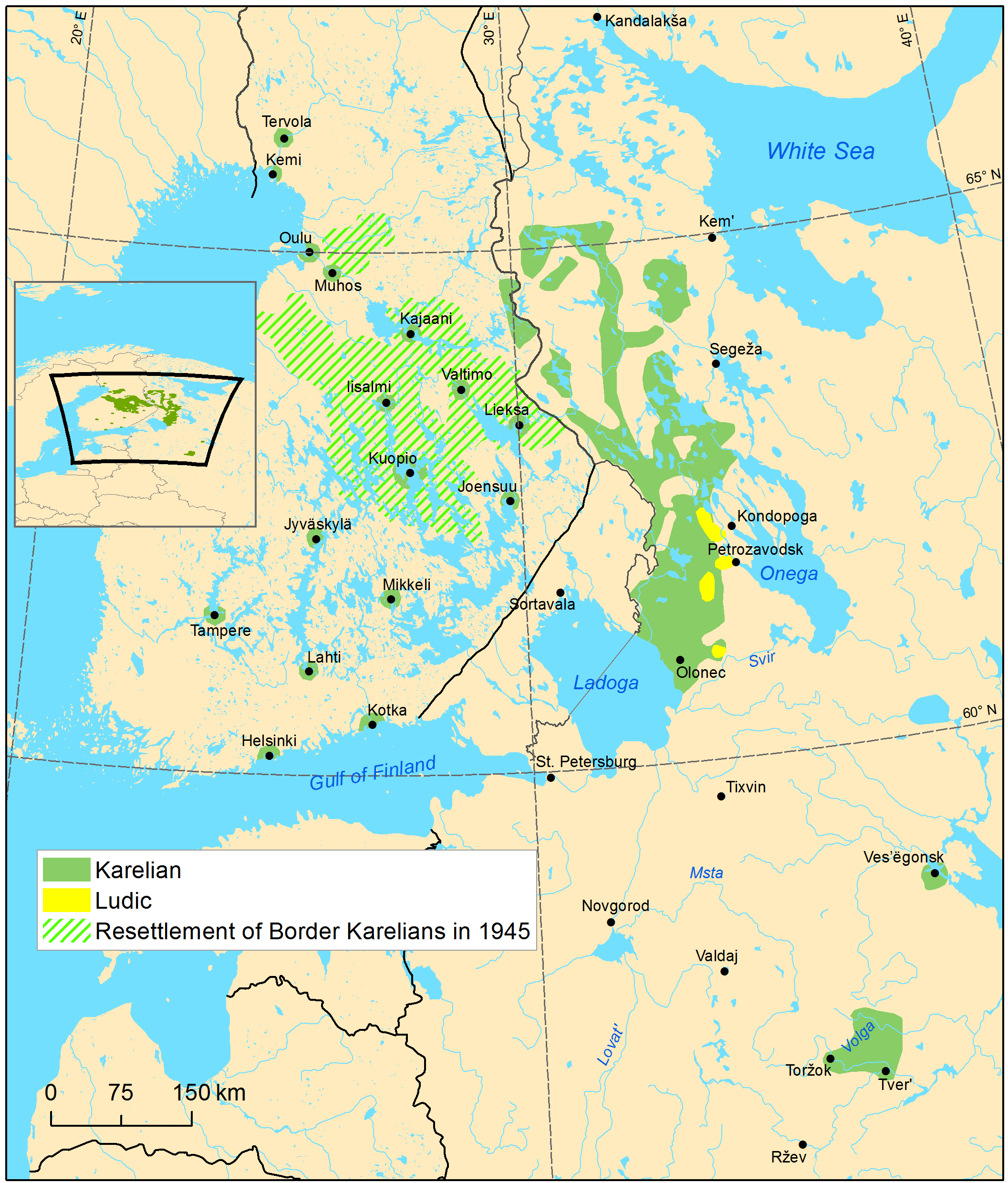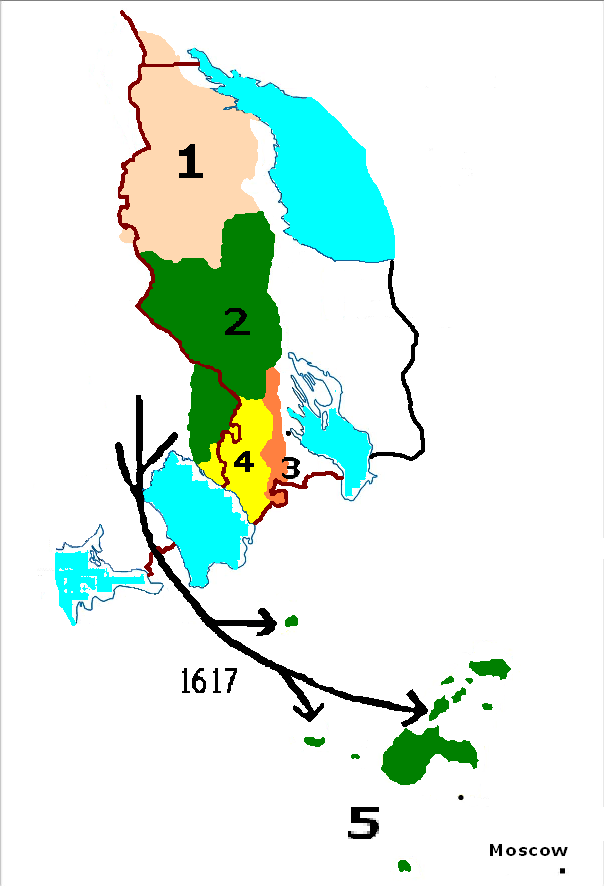|
Ingrian Language
Ingrian (, ), also called Izhorian (, , ), is a Finnic language spoken by the (mainly Orthodox) Izhorians of Ingria. It has approximately 70 native speakers left, most of whom are elderly. The Ingrian language should be distinguished from the Ingrian dialect of the Finnish language, which became the majority language of Ingria in the 17th century with the influx of Lutheran Finnish immigrants; their descendants, the Ingrian Finns, are often referred to as Ingrians. The immigration of Lutheran Finns was promoted by Swedish authorities, who gained the area in 1617 from Russia, as the local population was (and remained) Orthodox. Dialects Four dialect groups of Ingrian have been attested, two of which are probably extinct by now: * Hevaha, spoken along Kovashi River and nearby coastal areas (†) * Soikkola, spoken on Soikinsky Peninsula and along Sista River * Ylä-Laukaa (Upper Luga or Oredezhi), spoken along Oredezh River and the upper Luga River (†) * Ala-Laukaa (Lo ... [...More Info...] [...Related Items...] OR: [Wikipedia] [Google] [Baidu] |
Ingrian Dialects
Ingrian dialects () are the Finnish dialects spoken by Ingrian Finns around Ingria in Russia. Today, the Ingrian dialects are still spoken in Russia, Finland and Sweden. In 2010 there were only 20 300 Ingrian Finns left in Russia. The Ingrian dialects are gradually dying out, as primarily elderly people speak them still, and unlike Standard Finnish, the dialects are not taught in schools. History After Sweden annexed Ingria in 1617, many people moved to Ingria from Finland, at the time part of Sweden. After Russia annexed it again around 1700, many Russians moved in. However the Finnish language stayed because of the Lutheran church; the difference of religion made mixed marriages rare. In 1900 the situation changed a lot. At first, minority languages were supported; however, around 1930 Finnish was banned and the Ingrian Finns were deported and genocided. Because of this, language communities broke and Russian influence became larger. Phonology The phonology of Ingrian Fi ... [...More Info...] [...Related Items...] OR: [Wikipedia] [Google] [Baidu] |
Oredezh River
The Oredezh () is a river in Volosovsky, Gatchinsky, and Luzhsky Districts in the south-western part of Leningrad Oblast, Russia, a right tributary of the Luga. The length of the river is , whereas the area of its drainage basin A drainage basin is an area of land in which all flowing surface water converges to a single point, such as a river mouth, or flows into another body of water, such as a lake or ocean. A basin is separated from adjacent basins by a perimeter, ... is . The principal tributary of the Oredezh is the Suyda (left). A cascade of hydroelectric plants was constructed on the upper course of the river in 1948. The source of the Oredezh is located in Lake Kyurlevsky Karyer in the eastern part of Volosovsky District. The river flows south and crosses into Gatchinsky District. Upstream of the settlement of Batovo it turns east and flows through the urban-type settlements Siversky and Vyritsa. At the eastern edge of Vyritsa it sharply turns to the south a ... [...More Info...] [...Related Items...] OR: [Wikipedia] [Google] [Baidu] |
Northern Finnic Languages
The Finnic or Baltic Finnic languages constitute a branch of the Uralic language family spoken around the Baltic Sea by the Baltic Finnic peoples. There are around 7 million speakers, who live mainly in Finland and Estonia. Traditionally, eight Finnic languages have been recognized. The major modern representatives of the family are Finnish and Estonian, the official languages of their respective nation states.Finnic Peoples at The other Finnic languages in the Baltic Sea region are Ingrian and |
Veps Language
Veps, also known as Vepsian (, or ), is an endangered Finnic languages, Finnic language from the Uralic languages, Uralic language family, that is spoken by Vepsians. The language is written in the Latin script, and is closely related to Finnish language, Finnish and Karelian language, Karelian. According to Soviet Union, Soviet statistics, 12,500 people were self-designated ethnic Veps at the end of 1989. There were 5,900 self-designated ethnic Veps in 2010, and around 3,600 native speakers. According to the location of the people, the language is divided into three main dialects: Northern Veps (at Lake Onega to the south of Petrozavodsk, to the north of the river Svir River, Svir, including the former Veps National Volost), Central Veps (in the east of the Leningrad Oblast and northwest of the Vologda Oblast), and Southern Veps (in the Leningrad Oblast). The Northern dialect seems the most distinct of the three; however, it is still mutually intelligible for speakers of the oth ... [...More Info...] [...Related Items...] OR: [Wikipedia] [Google] [Baidu] |
Ludic Language
Ludic, Ludian, or Ludic Karelian ( or ), is a Finnic language in the Uralic language family or a Karelian dialect. It is transitional between the Olonets Karelian language and the Veps language. It is spoken by 300 Karelians in the Republic of Karelia in Russia, near the southwestern shore of Lake Onega, including a few children. Classification In the Finnish research tradition, Ludic has been considered a transitional dialect area between Karelian and Veps, while in the Russian research tradition it is, on ethnographic grounds, normally considered a dialect of Karelian. A status as an independent language has been proposed in recent times. Ludic is characterised by a specific mixture of Karelian-like traits (such as the diphthongisation of the Proto-Finnic non-open long vowels: e.g. *pää > ''piä'' 'head', *soo > ''suo'' 'swamp', contrast Veps ''pä'', ''so'') and Veps-like traits (such as an almost complete loss of consonant gradation). Like Veps, Ludic has also partially ... [...More Info...] [...Related Items...] OR: [Wikipedia] [Google] [Baidu] |
Livvi
Livvi-Karelian (Alternate names: ''Liygi'', ''Livvi'', ''Livvikovian'', ''Olonets'', ''Southern Olonetsian'', ''Karelian''; ) is a supradialect of Karelian, which is a Finnic language of the Uralic family, spoken by Olonets Karelians (self-appellation , ), traditionally inhabiting the area between Ladoga and Onega lakes, northward of Svir River. The name "Olonets Karelians" is derived from the territory inhabited, Olonets Krai, named after the town of Olonets, named after the Olonka River. History Before World War II, Livvi-Karelian was spoken both in Russia and in Finland, in the easternmost part of Finnish Karelia. After Finland was forced to cede large parts of Karelia to the USSR after the war, the Finnish Livvi-Karelian population was resettled in Finland. Today there are still native speakers of Livvi-Karelian living scattered throughout Finland, but all areas in which Livvi-Karelian remains a community language are found in Russia. Speakers of Livvi-Karelian may be ... [...More Info...] [...Related Items...] OR: [Wikipedia] [Google] [Baidu] |
Karelian Language
Karelian (; ; ; ) is a Finnic language spoken mainly by the Karelians, Karelian people in the Russian Republic of Karelia. Linguistically, Karelian is closely related to the Finnish language, Finnish dialects spoken in eastern Finland, and some Finnish linguists have even classified Karelian as a dialect of Finnish, but nowadays it is widely considered a separate language. Karelian is not to be confused with the South Karelian dialects, Southeastern dialects of Finnish, sometimes referred to as ("Karelian dialects") in Finland. In the Russian 2020–2021 census, around 9,000 people spoke Karelian natively, but around 14,000 said they were able to speak the language. There are around 11,000 speakers of Karelian in Finland, and around 30,000 people in Finland have at least some knowledge of Karelian. The Karelian language is a group of two supradialects. The two supradialects are Karelian Proper language, Karelian Proper (which comprises Northern Karelian dialect, Northern Kareli ... [...More Info...] [...Related Items...] OR: [Wikipedia] [Google] [Baidu] |
Substrate (linguistics)
In linguistics, a stratum (Latin for 'layer') or strate is a historical layer of language that influences or is influenced by another language through contact. The notion of "strata" was first developed by the Italian linguist Graziadio Isaia Ascoli, and became known in the English-speaking world through the work of two different authors in 1932. Both concepts apply to a situation where an intrusive language establishes itself in the territory of another, typically as the result of migration. Whether the superstratum case (the local language persists and the intrusive language disappears) or the substratum one (the local language disappears and the intrusive language persists) applies will normally only be evident after several generations, during which the intrusive language exists within a diaspora culture. In order for the intrusive language to persist, the ''substratum'' case, the immigrant population will either need to take the position of a political elite or immigrate i ... [...More Info...] [...Related Items...] OR: [Wikipedia] [Google] [Baidu] |
Karelian Isthmus
The Karelian Isthmus (; ; ) is the approximately stretch of land situated between the Gulf of Finland and Lake Ladoga in northwestern Russia, to the north of the River Neva. Its northwestern boundary is a line from the Bay of Vyborg to the westernmost point of Lake Ladoga, Pekonlahti. If the Karelian Isthmus is defined as the entire territory of present-day Saint Petersburg and Leningrad Oblast to the north of the Neva and also a tiny part of the Republic of Karelia, the area of the isthmus is about . The smaller part of the isthmus to the southeast of the old Russia-Finland border is considered historically as Northern Ingria, rather than part of the Karelian Isthmus itself. The rest of the isthmus was historically a part of Finnish Karelia. This was conquered by the Russian Empire during the Great Northern War in 1712 and included within the autonomous Grand Duchy of Finland (1809–1917) of the Russian Empire. When Finland became independent in 1917, the isthmus (excep ... [...More Info...] [...Related Items...] OR: [Wikipedia] [Google] [Baidu] |
Omsk
Omsk (; , ) is the administrative center and largest types of inhabited localities in Russia, city of Omsk Oblast, Russia. It is situated in southwestern Siberia and has a population of over one million. Omsk is the third List of cities and towns in Russia by population, largest city in Siberia after Novosibirsk and Krasnoyarsk, and the twelfth-largest city in Russia. It is an important transport node, serving as a train station for the Trans-Siberian Railway and as a staging post for the Irtysh, Irtysh River. During the Russian Empire, Imperial era, Omsk was the seat of the Governor General of Western Siberia and, later, of the Governor-Generalship of the Steppes, Governor General of the Steppes. For a brief period during the Russian Civil War in 1918–1920, it served as the capital of the anti-Bolshevik Russian State (1918–1920), Russian State and held the imperial gold reserves. Omsk serves as the episcopal see of the bishop of Omsk and Tara, Omsk Oblast, Tara, as well ... [...More Info...] [...Related Items...] OR: [Wikipedia] [Google] [Baidu] |
Siberian Ingrian Finnish
Siberian Ingrian Finnish (Russian language, Russian: Сибирский ингерманландский идиом) is a Lower Luga (river), Luga Ingrian dialects, Ingrian Finnish – Lower Luga Ingrian language, Ingrian (Izhorian) mixed language. The ancestors of the speakers of this language migrated from the area to Siberia in 1803–1804. Most native speakers of this language live in Ryzhkovo, Omsk Oblast, Ryzhkovo or nearby, as well as in Omsk and Tallinn (Estonia). History In the autumn of 1802, due to disobedience to their landowners, several dozen people with their families from the villages of , Malaya Arsiya, Bolshaya Arsiya, , Mertvitsa, , and Variva were exiled to Siberia. They arrived in the Kamyshinskaya volost of the Tobolsk Governorate in 1804. When the settlers founded the village, the name of the settlement was Chukhonskaya village (Russian: деревня Чухонская). The settlement also became known as Ryzhkovo, Omsk Oblast, Ryzhkovo (Russian: Р ... [...More Info...] [...Related Items...] OR: [Wikipedia] [Google] [Baidu] |
Mixed Language
A mixed language, also referred to as a hybrid language or fusion language, is a type of contact language that arises among a bilingual group combining aspects of two or more languages but not clearly deriving primarily from any single language. It differs from a creole language, creole or pidgin, pidgin language in that, whereas creoles/pidgins arise where speakers of many languages acquire a common language, a mixed language typically arises in a population that is fluent in both of the source languages. Because all languages show some degree of mixing by virtue of containing Loanword, loanwords, it is a matter of controversy whether the concept of a mixed language can meaningfully be distinguished from the type of contact and borrowing seen in all languages.Arends et al. 1994 Scholars debate to what extent language mixture can be distinguished from other mechanisms such as code-switching, Stratum (linguistics), substrata, or lexical borrowing. Definitions Other terms used in l ... [...More Info...] [...Related Items...] OR: [Wikipedia] [Google] [Baidu] |






